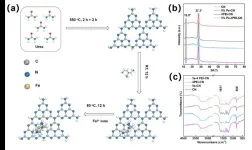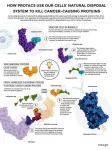(Press-News.org) COLLEGE PARK, Md. – In a head-to-head comparison of masks worn by people with active
COVID-19, the inexpensive “duckbill” N95 came out on top, stopping 98% of COVID-19 particles
in the breath of infected people from escaping into the air. Led by researchers from the University
of Maryland School of Public Health (SPH), results showed other masks also performed well,
blocking at least 70% of viral particles from escaping from the source – an infected person’s
exhaled breath.
The study, Relative efficacy of masks and respirators as source control for viral aerosol shedding
from people infected with SARS-CoV-2, published May 29 in eBioMedicine, a Lancet journal.
“The research shows that any mask is much better than no mask, and an N95 is significantly
better than the other options. That’s the number one message,” says the study’s senior author,
Dr. Donald Milton. Milton is a UMD SPH professor of environmental health and a global expert on
how viruses spread through the air.
The study started in May 2020, shortly after the pandemic began, and compared breath samples
from volunteers who had active COVID-19, testing the performance of four commonly-used
masks. Even without giving participants fit tests or training on how to wear masks correctly, all
masks significantly reduced the amount of virus escaping into the air. The study tested masks as
a way to control the spread of the virus from the source, i.e. the infected person, and did not test
masks as protection from COVID-19 in the surrounding air.
“Because COVID-19 is airborne, we focused on the extent to which wearing a mask reduces
contamination of the air around you,” Milton says. This latest study is a continuation of
investigations by UMD’s Public Health AeroBiology Lab (PHAB Lab) into how contagious
respiratory viruses such as influenza contaminate the air.
Researchers asked volunteers with COVID-19 to breathe into a unique contraption known as the
Gesundheit II Machine, developed by Milton and colleagues to measure viruses in exhaled
breath. Participants, who breathed into the machine for 30 minutes at a time, were asked to do a
variety of vocalizations such as repeating the alphabet, singing Happy Birthday, and even
honoring UMD’s mascot by repeatedly shouting “Go Terps!”
In each instance, researchers measured the amount of viral particles in the exhaled breath of
volunteers, pairing each 30-minute session of breathing with a mask on with another 30-minute
session with no mask.
“Data from our study suggests that a mildly symptomatic person with COVID-19 who is not
wearing a mask exhales a little over two infectious doses per hour,” says first author Dr. Jianyu
Lai, a postdoctoral researcher at the PHAB Lab. “But when wearing an N95 mask, the risk goes
down exponentially.”
The duckbill N95 blocked 99% of large particles and 98% of small particles from escaping out of
a person’s mask. Milton says the design’s tight seal, a powerful filter, and large air space for
breath to move around all contribute to the duckbill’s success.
Surprisingly, KN95 masks – the disposable masks used widely – were no more effective than
cloth or surgical masks. The study found that a common brand of KN95 masks leak more air than
duckbills or other studied masks, because they don’t conform to the face well. That flaw is
compounded by a powerful filter with more flow resistance that pushes air out of the mask at the
sides instead of through the filter, allowing more virus particles to escape into the surrounding air.
Cloth masks also outperformed both KN95 and surgical masks. Milton theorizes that cloth masks
with greater coverage, wrap around the face and give a better seal than either KN95 or surgical
masks. With cloth mask filters, flow resistance is also lower, allowing breath to pass through the
filter and not leak out the sides of the mask.
Limiting the amount of viral particles in the air is a key way to control highly contagious
respiratory viruses in general, Milton said. This is even more the case with the COVID-19 virus,
given transmissibility has increased over time, with Omicron in particular breaking through the
immunity people developed from vaccinations or prior infections.
“Our research shows definitively why it’s so important to have non-pharmaceutical responses like
wearing masks, and why we need studies like this to illuminate which masks are most effective,”
says Milton.
Both Milton and Lai hope that their findings will inform health policies going forward, including
when combatting potential outbreaks like bird flu or even the common flu.
“Duckbill N95 masks should be the standard of care in high-risk situations, such as nursing
homes and health care settings,” Lai says. “Now, when the next outbreak of a severe respiratory
virus occurs, we know exactly how to help control the spread, with this simple and inexpensive
solution.”
In addition to researchers from the UMD School of Public Health, collaborators include authors
from the UMD A. James Clark School of Engineering and the World Health Organization
Collaborating Centre for Infectious Disease Epidemiology and Control at the University of Hong
Kong, China.
This research was supported by the Prometheus-UMD, sponsored by the Defence Advanced
Research Projects Agency (agreement N66001-18-2-4015), the National Institute of Allergy and
Infectious Diseases Centers of Excellence for Influenza Research and Surveillance (contract
12-HHSN272201400008C), and the Centers for Disease Control and Prevention (contract
200-2020-09528); by a grant from the Bill & Melinda Gates Foundation; and by a gift from The
Flu Lab.
##
END
University of Maryland study shows N95 masks near-perfect at blocking escape of airborne COVID-19
Study finds all masks effective, but “duckbill” N95 masks far outperform others, suggests they should be the standard in high-risk settings
2024-05-30
ELSE PRESS RELEASES FROM THIS DATE:
The AI paradox: Building creativity to protect against AI
2024-05-30
Cultivating creativity in schools is vital for a future driven by artificial intelligence (AI). But while teachers embrace creativity as an essential 21st century skill, a lack of valid and reliable creativity tests means schools struggle to assess student achievement.
Now, a new machine-learning model developed by the University of South Australia is providing teachers with access to high-quality, fit-for-purpose creativity tests, that can score assessments in a fraction of the time and a fraction of the cost.
Applied to the current ...
Visible light-induced photocatalysis–self-Fenton degradation of P-Clphoh over graphitic carbon nitride by a polyethylenimine bifunctional catalyst
2024-05-30
The deep degradation of organic pollutants through solar light-coupled photocatalysis and the Fenton reaction (Photo-Fenton) holds significant importance in the field of water purification. In this study, a novel bifunctional catalyst (Fe-PEI-CN) was synthesized by electrostatic self-assembly and hydrothermal methods, doping graphene-like carbon nitride (CN) with polyethyleneimine (PEI) and iron (Fe) species. This catalyst efficiently degraded p-chlorophenol (p-ClPhOH) by generating hydrogen peroxide (H2O2) during the photocatalytic process. The relationship between catalytic efficiency and structure was explored using various characterization techniques.Under ...
Engineered DNA 'warhead' targets a common cancer mutation
2024-05-30
Tumour protein P53 (TP53) plays an important role in suppressing the growth of tumours. Mutations in the gene for TP53 can have a disastrous effect, hampering the body's ability to fight tumours and even encouraging their growth. Because these are the most common mutations in cancers, TP53 has long been an interesting therapeutic target. However, efforts to destroy the mutant protein have been hampered by the difficulty of finding a way to bind to it.
Now, a team of researchers from Xi'an ...
Picture this: Snapping photos of our food could be good for us
2024-05-30
New Curtin University research reveals taking pictures of food isn’t just content for our social media feeds, but could be the key to improving people’s diets.
Published in the prestigious American Journal of Clinical Nutrition, the feeding study saw researchers measure the weight of meals, which were then provided to participants over a day for breakfast, lunch and dinner.
Participants compared different technology-assisted methods to recall what they had eaten over the past 24 hours.
One method asked participants to take photos of their meals using the mobile Food Record app.
These ...
Portable pathology passes the test
2024-05-30
On-site pathology tests for infectious diseases in rural and remote locations can be just as reliable and accurate as tests carried out in a hospital laboratory, a new report from Flinders University shows.
Flinders University researchers tested the quality of on-site pathology testing, or Point-of-Care-Testing (POCT), for molecular-based, severe acute respiratory syndrome coronavirus 2 (SARS-CoV-2) detection in over 100 remote Aboriginal and Torres Strait Islander communities across Australia.
“Our study demonstrates that when point-of-care testing models are effectively established and managed, the quality of pathology results can be equivalent to ...
USC medical school dean appointed to CIRM board
2024-05-30
Carolyn C. Meltzer, MD, dean of the Keck School of Medicine of USC, has been appointed to the board overseeing the California Institute of Regenerative Medicine (CIRM). CIRM is the voter-created agency that funds stem cell research throughout the state.
“Stem cell research holds the tremendous promise to unlock health solutions that patients need,” said Steven D. Shapiro, MD, USC’s senior vice president for health affairs. “The CIRM board—and the people of our state—will benefit greatly from Meltzer’s wide-ranging leadership experience and place at the ...
Antibiotic pollution disrupts the gut microbiome and blocks memory in aquatic snails
2024-05-30
Antibiotics prevent snails from forming new memories by disrupting their gut microbiome - the community of beneficial bacteria found in their guts.
The new research, led by the University of East Anglia (UEA) in collaboration with Aberystwyth University, highlights the damaging effects that human pollution could be having on aquatic wildlife.
In the study, pond snails were given a favourite food – carrot juice – but had to quickly learn and remember that it was no longer safe to eat.
Snails ...
Researchers expose new symbiosis origin theories, identify experimental systems for plant life
2024-05-30
STARKVILLE, Miss.— A Mississippi State faculty member’s work on symbiosis—a mutually beneficial relationship between living organisms—is pushing back against the newer theory of a “single-origin” of root nodule symbiosis (RNS)—that all symbiosis between plant root nodules and nitrogen-fixing bacteria stems from one point—instead suggesting a “multiple-origin” theory of symbiosis which opens a better understanding for genetically engineering crops.
Ryan A. Folk, an assistant professor in the MSU Department of Biological Sciences and herbarium curator, is an author on a paper published this month in Nature ...
Q&A: How AI affects kids’ creativity
2024-05-30
Shortly after artificial intelligence models including Midjourney and OpenAI’s Dall-E went public, AI-generated art started winning competitions: one in digital art, another in photography. Concern rumbled that AI could replace artists — and even, by some metrics, be more creative than humans. But simultaneously, people were exploring these tools as ways to augment their creative processes, not replace them.
University of Washington researchers grew curious about how AI might affect creativity in children, specifically, so they worked with a group of 12 Seattle-area kids ages seven to 13 to explore how the kids’ creative processes interacted ...
Virtual lab meetings improve undergraduate research experience and foster diversity in academia
2024-05-30
Moisés A. Bernal, assistant professor in the Department of Biological Sciences at Auburn University, is collaborating with researchers Kathleen Lotterhos (Northeast University), Megan Phifer-Rixey (Drexel University), and Torrance Hanley, (Sacred Heart University) to evaluate the effectiveness of virtual lab meetings in demystifying the hidden curriculum in academia, incentivize primary research among students without previous experience, and foster participation of underrepresented groups in STEM.
The “Biological Practices” article entitled A virtual lab meeting training program mutually benefits mentees and host labs was recently published ...
LAST 30 PRESS RELEASES:
Fertility remains high in rural Tanzania despite access to family planning
AI-assisted device can improve autism care access
Kinetic careers
Uncovering how parasitic plants avoid attacking themselves to improve crop resistance
Nanoparticle vaccine strategy could protect against Ebola and other deadly filoviruses
Study finds brain care score can predict risk of stroke across racial groups
Key lung immune cells can intensify allergic reactions
Do hormones explain why women experience more gut pain?
New materials conduct ions in solids as easily as in liquids
Breakthrough of the Year: Renewable energy begins to eclipse fossil fuel-based sources
LLM use is reshaping scientific enterprise by increasing output, reducing quality and more
Introducing LightGen, a chip for ultra-fast, ultra-efficient generative AI
Astronomers see fireworks from violent collisions around nearby star
ACC/AHA issue new guideline on managing congenital heart disease in adults
Cosmic crash caught on camera
Is talented youth nurtured the wrong way? New study shows: top performers develop differently than assumed
Ants: An untapped resource in the development of antibiotics?
Archaeologists use AI to create prehistoric video game
Mitochondria migrate toward the cell membrane in response to high glucose levels
Tiny viral switch offers hope against drug-resistant bacteria
Most parents aware of early peanut introduction guidelines, but confused about details
HPV vaccine can protect against severe lesions of the vulva and vagina
Virtual care provision and emergency department use among children and youth
Quadrivalent HPV vaccine and high-grade vulvovaginal lesions
Insights into dry eyes gained from stem cell-derived tear glands
Researchers identify 166 human pluripotent stem cell lines available for use in clinical applications
Europa Clipper instrument uniquely observed interstellar comet 3I/ATLAS
UN University Report challenges climate change as sole trigger of Syrian Civil War, exposing governance failures in drought response
Real estate investment trust (REIT) acquisition associated with hospital closure and bankruptcy
New Raman imaging system detects subtle tumor signals
[Press-News.org] University of Maryland study shows N95 masks near-perfect at blocking escape of airborne COVID-19Study finds all masks effective, but “duckbill” N95 masks far outperform others, suggests they should be the standard in high-risk settings





